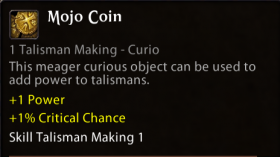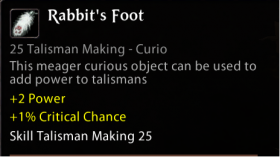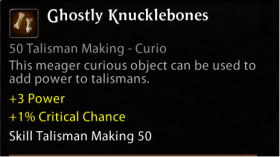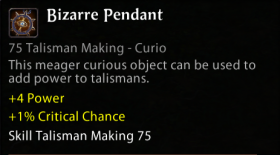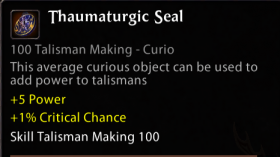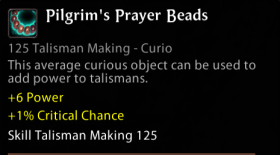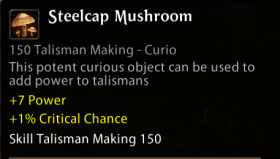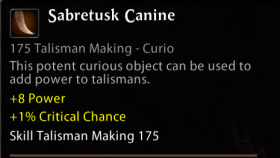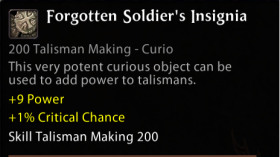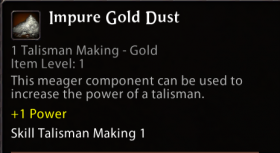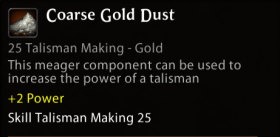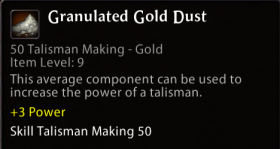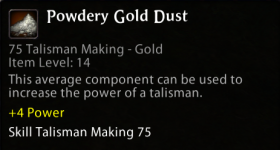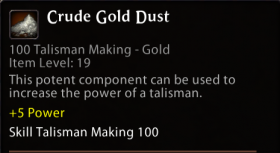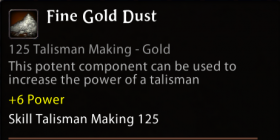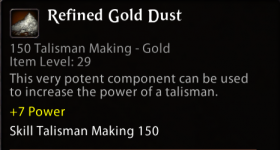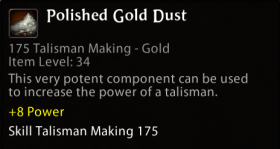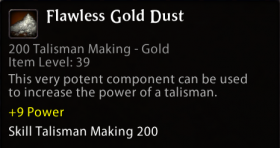Scavenging: Difference between revisions
No edit summary |
(First part of the update for Scavenging page. 20% done. Coming back to add more soon.) |
||
| Line 1: | Line 1: | ||
== Scavenging == | |||
'''Scavenging''' is a Gathering skill in Return of Reckoning that can be used to acquire crafting materials, like Talisman Fragments, Curios and Gold Dust. | |||
As these materials are most useful for the [[Talisman Making]] profession, it's common to pair Scavenging alongside it. | |||
To learn the Scavenging skill, head to your Capital City of choice and look for: | |||
*Order: Elsbeth Reiss, [[Altdorf]] Market. | |||
*Destruction: Lorne Foulsteel, [[The Inevitable City]] Apex. | |||
== Let's loot some corpses! == | |||
Armed with the knowledge on how to check a dead person's pockets, it's time to Scavenge your first body. | |||
Head into the open world and kill any humanoid NPC, then loot the corpse of any item it dropped. Once the body has no more items, you'll see a Pliers icon that indicates you can right click to Scavenge the corpse. | |||
When Scavenged, the NPC corpse will vanish and you'll gain the looted item. | |||
== Scavenging Info == | |||
* Leveling up the gathering skill, Scavenging, happens through the killing and looting of humanoid type NPCs in Return of Reckoning. When you kill the humanoid NPC, right click on the corpse or use your loot hotkey to first obtain whatever items and coin dropped from the mob, then right click or loot hotkey again to obtain a scavenging material from the corpse. | * Leveling up the gathering skill, Scavenging, happens through the killing and looting of humanoid type NPCs in Return of Reckoning. When you kill the humanoid NPC, right click on the corpse or use your loot hotkey to first obtain whatever items and coin dropped from the mob, then right click or loot hotkey again to obtain a scavenging material from the corpse. | ||
* Once a material is successfully looted, the corpse will disappear. | * Once a material is successfully looted, the corpse will disappear. | ||
| Line 11: | Line 29: | ||
* Any class can Scavenge, but if you're going to have one character with each gathering skill ([[Butchering]], [[Cultivating]], [[Salvaging]]), it's good to consider learning Scavenging on a class that can farm Champions easily. Scavenging can be an effective gathering skill for classes with reasonable single target damage and high sustain or kite potential. [[High Elf, Shadow Warrior|Shadow Warrior]], [[Warrior Priest]], [[Dark Elf, Disciple of Khaine|Disciple of Khaine]], [[Marauder]], and [[Squig Herder]] all make good Scavengers. | * Any class can Scavenge, but if you're going to have one character with each gathering skill ([[Butchering]], [[Cultivating]], [[Salvaging]]), it's good to consider learning Scavenging on a class that can farm Champions easily. Scavenging can be an effective gathering skill for classes with reasonable single target damage and high sustain or kite potential. [[High Elf, Shadow Warrior|Shadow Warrior]], [[Warrior Priest]], [[Dark Elf, Disciple of Khaine|Disciple of Khaine]], [[Marauder]], and [[Squig Herder]] all make good Scavengers. | ||
== List of | == List of Items Obtained Through Scavenging == | ||
You can obtain gold dust and curios from scavenging humanoid corpses for Talisman Making, as well as fragments. Gold Dust can also be obtained through [[Salvaging]], but Curios and some fragments can only be obtained through Scavenging. For a list of fragments, please visit the [[Talisman Making]] page. Curios and Gold Dust are listed below. | You can obtain gold dust and curios from scavenging humanoid corpses for Talisman Making, as well as fragments. Gold Dust can also be obtained through [[Salvaging]], but Curios and some fragments can only be obtained through Scavenging. For a list of fragments, please visit the [[Talisman Making]] page. Curios and Gold Dust are listed below. | ||
{| class="wikitable" | |||
=== List of Curios === | |||
Click expand below for the full list of Tradable Curios: | |||
{| class="mw-collapsible mw-collapsed wikitable" | |||
! | |||
|- | |- | ||
|1 | |[[File:Mojo coin 1.png|center|280px]]||[[File:rabbits Foot 25.png|center|280px]]||[[File:Ghostly Knucklebones.png|center|280px]] | ||
| | |||
| | |||
|- | |- | ||
| | |[[File:Bizarre Pendant.png|center|280px]]||[[File:Thaumaturgic Seal 100.png|center|280px]]||[[File:Pilgrims Prayer Beads.png|center|280px]] | ||
| | |||
| | |||
|- | |- | ||
| | |[[File:Steelcap Mushroom.png|center|280px]]||[[File:Sabretusk Canine 175.png|center|280px]]||[[File:Forgotten Soldiers Insignia 200.png|center|280px]]|| | ||
| | |} | ||
| | |||
*Most curious are found by Scavenging, and you can also trade or buy these from other players via the Auction House. | |||
*Players with access to Guild Merchants can purchase level 25, 75, and 125 Curios from the Quartermaster in either [[Sigmar's Hammer]] or [[The Viper Pit]]. | |||
=== List of Gold Dust === | |||
Click expand below for the full list of Gold Dust. | |||
{| class="mw-collapsible mw-collapsed wikitable" | |||
! | |||
|- | |- | ||
| | |[[File:Impure Gold Dust.png|center|280px]]||[[File:Coarse Gold Dust.png|center|280px]]||[[File:Granulated Gold Dust.png|center|280px]]||[[File:Powdery Gold Dust.png|center|280px]]||[[File:Crude Gold Dust.png|center|280px]] | ||
| | |||
| | |||
|- | |- | ||
| | |[[File:Fine Gold Dust.png|center|280px]]||[[File:Refined Gold Dust.png|center|280px]]||[[File:Polished Gold Dust.png|center|280px]]||[[File:Flawless Gold Dust.png|center|280px]]|| | ||
| | |||
| | |||
| | |||
|Gold Dust | |||
| | |||
| | |||
| | |||
|Gold Dust | |||
| | |||
| | |||
| | |||
|Gold Dust | |||
| | |||
| | |||
| | |||
| | |||
|} | |} | ||
*Gold Dust can be found both by Scavenging and by [[Salvaging|Magical Salvaging]]. The level of the mob you scavenge or gear you salvage determines which Dust you'll receive. | |||
Revision as of 18:58, 23 June 2022
Scavenging
Scavenging is a Gathering skill in Return of Reckoning that can be used to acquire crafting materials, like Talisman Fragments, Curios and Gold Dust.
As these materials are most useful for the Talisman Making profession, it's common to pair Scavenging alongside it.
To learn the Scavenging skill, head to your Capital City of choice and look for:
- Order: Elsbeth Reiss, Altdorf Market.
- Destruction: Lorne Foulsteel, The Inevitable City Apex.
Let's loot some corpses!
Armed with the knowledge on how to check a dead person's pockets, it's time to Scavenge your first body.
Head into the open world and kill any humanoid NPC, then loot the corpse of any item it dropped. Once the body has no more items, you'll see a Pliers icon that indicates you can right click to Scavenge the corpse.
When Scavenged, the NPC corpse will vanish and you'll gain the looted item.
Scavenging Info
- Leveling up the gathering skill, Scavenging, happens through the killing and looting of humanoid type NPCs in Return of Reckoning. When you kill the humanoid NPC, right click on the corpse or use your loot hotkey to first obtain whatever items and coin dropped from the mob, then right click or loot hotkey again to obtain a scavenging material from the corpse.
- Once a material is successfully looted, the corpse will disappear.
- The level of material that drops is first checked by your skill level, then by NPC level. It's a simple calculation: if you want material of a specific level, divide the material level by 5. This represents the minimum level mob that will drop the material. You can kill mobs within the range of four levels above that. For example, if I want to obtain level 50 materials, I need to farm level 10-14 mobs. 50 divided by 5 equals 10, plus 4 is 14. Level 15 mobs will drop level 75 materials.
- You can only receive materials within the range of your skill level. For example, if you are killing level 20 mobs to get level 100 materials to drop, but your skill level in Scavenging is 92, you will only receive level 75 materials and lower.
- Each humanoid corpse you loot will have a chance to level your Scavenging skill by one point, as long as it is within or above your skill level. For example, say my Scavenging is currently level 75, and I'm killing level 20-24 mobs (which drop level 100 materials). I'll have a very good chance to level my Scavenging up through level 100. If I'm killing level 15-19 mobs (which drop level 75 materials), I'll have a normal chance to level my Scavenging through 75 (I might see a slow-down somewhere around 90 because the chance to level is shrinking as I continue leveling up); and if I'm killing level 10-14 mobs (which drop level 50 materials), I'll have a very low, or zero, chance to increase my Scavenging past 75.
- Only Champion NPCs and above will drop purple fragments. Normal NPCs will drop Common (white), Uncommon (green), and Rare (blue) fragments.
- The maximum level for all gathering and trade skills is 200.
- Any class can Scavenge, but if you're going to have one character with each gathering skill (Butchering, Cultivating, Salvaging), it's good to consider learning Scavenging on a class that can farm Champions easily. Scavenging can be an effective gathering skill for classes with reasonable single target damage and high sustain or kite potential. Shadow Warrior, Warrior Priest, Disciple of Khaine, Marauder, and Squig Herder all make good Scavengers.
List of Items Obtained Through Scavenging
You can obtain gold dust and curios from scavenging humanoid corpses for Talisman Making, as well as fragments. Gold Dust can also be obtained through Salvaging, but Curios and some fragments can only be obtained through Scavenging. For a list of fragments, please visit the Talisman Making page. Curios and Gold Dust are listed below.
List of Curios
Click expand below for the full list of Tradable Curios:
- Most curious are found by Scavenging, and you can also trade or buy these from other players via the Auction House.
- Players with access to Guild Merchants can purchase level 25, 75, and 125 Curios from the Quartermaster in either Sigmar's Hammer or The Viper Pit.
List of Gold Dust
Click expand below for the full list of Gold Dust.
- Gold Dust can be found both by Scavenging and by Magical Salvaging. The level of the mob you scavenge or gear you salvage determines which Dust you'll receive.
